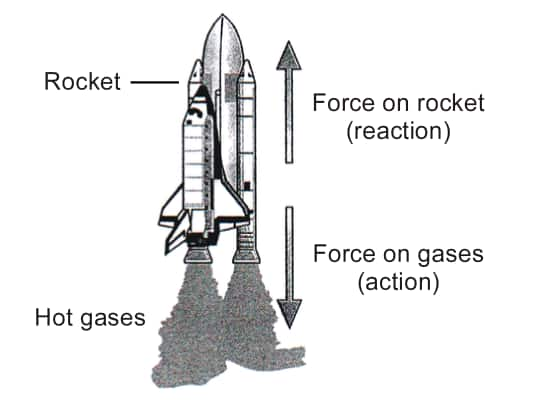Force and Laws of Motion Class 9th Notes - Free NCERT Class 9 Science Chapter 9 Notes - Download PDF
Have you ever felt a jerk when a moving bus suddenly stops, or have you ever noticed how a rolling ball will come to rest? These are common observations which are well illustrated in Class 9 Chapter 8: Force and Laws of Motion. The NCERT Class 9 Science Notes make the fundamentals of motion and Newton Laws much simpler, which is why this chapter is not only vital in exams of the schools but competitive exams, such as JEE, NEET, NTSE, and Olympiads.
This Story also Contains
- NCERT notes Class 9 Science Chapter 8 Force and Laws of Motion: Download PDF
- NCERT notes Class 9 Science Chapter 8 Force and Laws of Motion
- How to Master Class 9 Science Chapter 8 Force and Laws of Motion?
- Importance of Class 9 Physics Chapter 8 Force and Laws of Motion Notes
- NCERT Notes Class 9 Science Chapter-Wise
All the concepts of Chapter 8 of the Force and Laws of Motion of Class 9 are introduced in the NCERT notes Class 9 Science Chapter 8 Force and Laws of Motion, which are student-friendly. The effects of force, inertia, balanced forces, and unbalanced forces, as well as the three laws of Newton, are addressed in NCERT notes Class 9 Science Chapter 8 Force and Laws of Motion in easy-to-understand ways. Real-life examples, well-labelled diagrams, important definitions, and exam-based points are also provided in these notes according to the recent CBSE Class 9 syllabus of Sciences. These NCERT notes are written so that they can be revised quickly and have a solid conceptual basis to prepare students efficiently and form the foundation of higher-level physics.
Also Read
NCERT notes Class 9 Science Chapter 8 Force and Laws of Motion: Download PDF
The Class 9 Science Chapter 8 Force and Laws of Motion Notes are well designed and clearly explain all the key concepts in a manner that allows students to strengthen themselves at the fundamental level. The Force and Laws of Motion Class 9 Science Notes have been compiled by experts on the basis of the latest CBSE syllabus and are thus good to revise and prepare exams in a short period of time. By making things simpler in terms of explanations, diagrams, formulae and highlights, these notes guarantee greater clarity and higher scores in exams. The Class 9 Science Chapter 8 Notes PDF can also be downloaded and can be studied at any time whenever the students want to do it.
NCERT notes Class 9 Science Chapter 8 Force and Laws of Motion
The Force and Laws of Motion Class 9 Science Chapter 8 CBSE notes are written in a simplified and student-friendly manner, in which all the important concepts are explained so as to build your physics background. These Force and Laws of Motion Class 9 Science Notes are prepared as per the latest CBSE syllabus and hence they are perfect for revision and examination preparation. These notes will make the students grasp the concepts more quickly and have higher scores in assessments with clear explanations, diagrams, formulae, and essential details. These properly arranged notes can also be applied to creating a solid foundation in higher classes.
Force
Force is a push or pull on an object; it can change the velocity of an object, change its direction of motion or change the size or shape of the object.
Effect of Force
(i) It may change its state of rest or of uniform motion.
(ii) It may change its direction of motion.
(iii) It may change its shape.
Balanced and unbalanced forces
Balanced Force
When a number of forces acting simultaneously on a body do not bring about any change in its state of rest or of uniform motion along a straight line, then the forces acting on the body are said to be balanced forces. In this case, different forces acting on a body give zero resultant. Balanced forces do not produce any acceleration.
For example, when two opposite forces having the same magnitude $F$ act on a block placed on a smooth horizontal table, they fail to move the block.

This is because the net force is equal to zero. Similarly, two opposite forces having the same magnitude cannot change the speed of a moving body.
Unbalanced Force
When a number of forces acting simultaneously on a body bring about a change in its state of rest or of uniform motion along a straight line, then these forces acting on the body are said to be unbalanced forces. In this case, different forces acting on the body do not give a zero resultant. If an unbalanced force is applied on the object, there will be a change either in its speed/velocity or in the direction of its motion. Thus, to accelerate an object, an unbalanced force is required.
When the net force on the body is not equal to zero, then the body at rest starts moving in the direction of the resultant force.
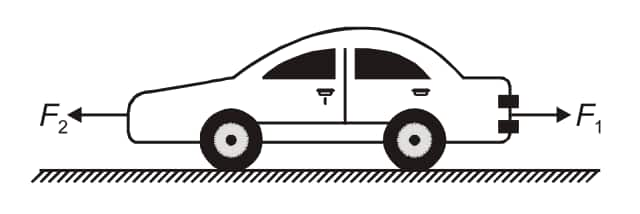
If $F_2>F_1$, then $F_2-F_1>0$, as a result, the car accelerates in the direction of $F_2$.
First law of motion
Galileo observed the motion of objects on an inclined plane and concluded that no net force is needed to sustain an object’s uniform motion.
The first law of motion states that until driven to change by an applied force, an object will stay in a condition of rest or uniform motion in a straight path.
The first law of motion states that when an object is subjected to an unbalanced external force, its velocity changes, or the object accelerates. Newton's first law of motion, often known as the law of inertia, emphasises objects' ability to resist change in velocity.
Inertia and mass
Inertia is the tendency of a body to maintain its state of rest or of uniform motion on its own, or we can say that it is the inability of a body to change its state of rest or of uniform motion on its own.
Inertia and mass: Consider two bodies of unequal masses, say a table tennis ball and a cricket ball. If both balls are pushed with equal force for the same time, a cricket ball will have a much smaller velocity as compared to a tennis ball. A cricket ball has more resistance than a table tennis ball. Or, a cricket ball has larger inertia than a table tennis ball. So, we can generalise, a heavier body has a larger inertia than a lighter body. The same is true for objects in motion, also. If you have to stop a lighter body and a heavy body moving with equal velocities, you may stop the lighter body with your hands (depending on its velocity), while the heavier one may slow down only a little (depending on its velocity).
The larger the mass, the larger is the inertia. Hence, we may say mass is a measure of inertia.
Second law of motion
Linear Momentum
It is defined as the quantity of motion contained in a body. It is measured as the product of the mass of the body and its velocity and has the same direction as that of the velocity. It is a vector quantity. It is represented by $p$.
Linear momentum $(p)=$ mass $(m) \times$ velocity $(v)$
or
$
p=m v
$
The SI unit of linear momentum is $\mathrm{kg} \mathrm{m} / \mathrm{s}$.
Second law of motion: The rate of change of linear momentum of a body is directly proportional to the applied unbalanced external force, and it is in the direction of the resultant force.
Consider a body of mass $m$ moving with some initial velocity $u$. If an unbalanced constant force is applied and it changes its velocity from $u$ to $v$ in time $t$, then the acceleration of the body
$
a=\frac{\text { change in velocity }}{\text { time taken }}=\frac{v-u}{t}
$
The initial linear momentum of the body is
$
p_i=m u
$
and final linear momentum, $p_f=m v$
The change in linear momentum $=p_f-p_i$
$
\begin{aligned}
& =m v-m u \\
& =m(v-u)
\end{aligned}
$
Therefore, the rate of change of linear momentum $\frac{m(v-u)}{t} \propto \text { }$Applied unbalanced force(F)
$
F \propto \frac{m[v-u]}{t}
$
or $F \propto m a$
or $F=k m a$
where $k$ is a constant of proportionality. The unit of force is so chosen that here the value of the constant $k$ becomes one.
The SI unit of force is newton, represented by ' $N$ '.
$
\therefore \quad F=m a
$
Application of Newton's Second Law of Motion
1. A cricket player lowers his hand while catching the ball: The player increases the time during which the high velocity of the moving ball reduces to zero.
$F \times \Delta t=m(v-u)$
$u$ is very large, $v=0$,
$m(v-u)$ is fixed.
If we increase $\Delta t, F$ decreases, so the force of impact on the palm of the fielder reduces. Hence, he is able to catch the ball without injuring himself.
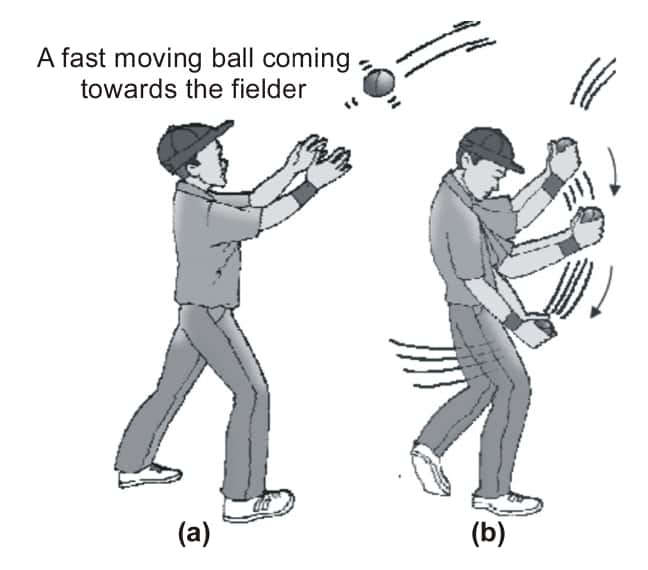
2. A karate player can break a pile of tiles with a single blow of his hand: Because he strikes the pile of tiles with his hand very fast, during which the entire linear momentum of the fast-moving hand is reduced to zero in a very short interval of time. This exerts a very large force on the pile of tiles, which is sufficient to break them, by a single blow of his hand.
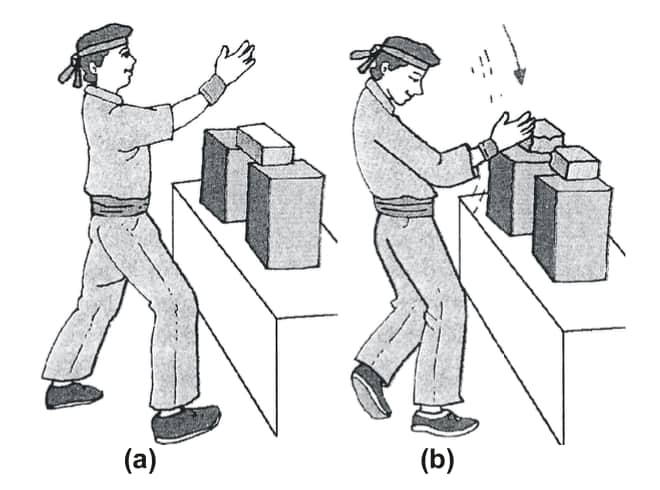
Third law of motion
When one object puts a force on another, the second object reacts by exerting a force on the first, according to the third law of motion. These two forces have the same magnitude; however operate in opposing directions and on separate objects.
Applications of the Third Law
1. Recoiling of a gun: When a bullet is fired from a gun, it exerts a forward force on the bullet, and the bullet exerts an equal (in magnitude) and opposite (in direction) force on the gun.
2. To walk, we press the ground in a backward direction with our feet: When we walk on the ground, our feet push the ground backward, and in return, the ground pushes our feet forward.
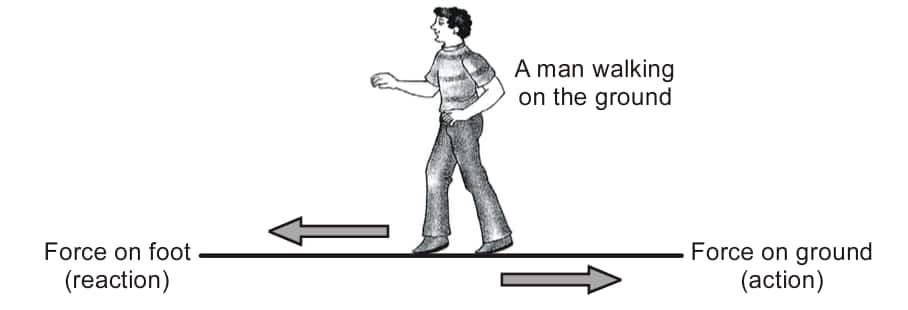
3. Jet aeroplanes and rockets: In jet engines and rockets, the fuel is burnt to produce a large quantity of hot gases. These hot gases come out of a nozzle with a great force (this is action). According to the third law of motion, the equal (in magnitude) and opposite (in direction) reaction pushes the jet planes and rockets upward with great speed (this is a reaction).
How to Master Class 9 Science Chapter 8 Force and Laws of Motion?
Learning Class 9 Science Chapter 8: Force and Laws of Motion will be easy when you master the concept using real-life examples and practice. This chapter prepares you for the foundation of the next higher classes and competitive exams, such as JEE and NEET. Going with the right strategy, you could learn definitions, formulas, and laws in an easy and efficient manner.
- First of all, to learn the fundamentals of force, inertia, momentum, and the laws developed by Newton, it is important to read the NCERT textbook and understand the basic concepts.
- Be familiar with each of the three laws of Newton and their practical uses in the world to develop a solid conceptual clarity.
- Memorise and practice questions on important formulas as F = ma and p = mv, by using them in numerical problems.
- Solve all NCERT exercise questions, examples, and additional questions to strengthen numerical and theoretical understanding.
- Relate the concepts with real-life situations such as pushing a trolley, jumping off a bus or kicking a ball to learn how the laws apply in real life.
- Draw neat and well-labelled diagrams wherever necessary to visualise concepts better.
- Prepare short notes containing definitions, key points, and formulas for quick revision.
- Revise the chapter regularly to retain concepts and avoid confusion during exams.
- Practice previous year questions, sample papers, and extra worksheets to develop speed and confidence.
Importance of Class 9 Physics Chapter 8 Force and Laws of Motion Notes
The significance of the Force and Laws of Motion Class 9 Science Chapter 8 CBSE notes is that it enables the student to have a clear picture of the underlying laws that control any form of movement. These Force and Laws of Motion Class 9 Science Notes simplify complex ideas in easy-to-understand explanations and so one can easily understand force, inertia, momentum, and the three laws of Newton. They contain some major formulas, diagrams, and real-life examples that allow learning to be more relatable and enable students be able to remember the concepts longer. The notes are also very vital in forming a solid ground towards higher classes, particularly Class 11 and 12 Physics, in which mechanics are more advanced. They enhance solving skills with numericals, clear up common doubts, and equip students adequately to face school exams and also competitive exams such as JEE, NEET, NTSE and Olympiads. The notes are concise and well organised, and thus the students revise quickly, have a better understanding of concepts, and do better in exams.
NCERT Notes Class 9 Science Chapter-Wise
The NCERT Notes for Class 9 Science Chapter-Wise provide a complete and structured resource to help students revise every chapter with ease and accuracy. They are designed by subject experts in accordance with the new CBSE syllabus and make difficult concepts easy to understand in the form of essential points, diagrams, and formulas. They come in handy when there is a need to revise in a short time, provide homework, and prepare for exams. The chapter links allow the student to reach every topic with ease and build on the Class 9 Science foundation.
NCERT Solutions Of Class 9 Subject-Wise
NCERT Class 9 Exemplar Solutions for Other Subjects:
Frequently Asked Questions (FAQs)
All of the necessary formulas, including F = ma (Force = mass × acceleration) and the momentum formulas, are listed in detail in the revision notes. You may easily remember the right approach and use it to confidently solve numerical problems during your test by going over these and the important examples given.
Assuming that the forces of action and reaction cancel each other out is a common mistake. They always act on different objects, hence this is untrue. For instance, when a swimmer pushes the water backward (action), the water pulls the swimmer forward (reaction). Because one force acts on the water and the other on the swimmer, they do not cancel each other out.
The SI unit of force is Newton.
Inertia is the property of an object to resist the change in its state of motion, if it’s in motion, it tends to be in motion, if it’s in rest, it’ll tend to remain at rest.
When the magnitude of the net force applied on an object is zero, there will be no change in the object’s state of motion, such forces on the object are termed as balanced forces.
According to class 9th science chapter 9 notes Momentum (p) is the product of an object’s mass (m) and its velocity (v)
p=mv. The direction of momentum is the same as that of velocity, and its SI unit is kg m/s
The total momentum of the two objects is unchanged or conserved by the collision. These topics can also be downloaded from Class 9 Science chapter 9 notes pdf download.
Popular Questions
Courses After 12th
Applications for Admissions are open.
As per latest syllabus. Physics formulas, equations, & laws of class 11 & 12th chapters
JEE Main Important Chemistry formulas
Get nowAs per latest syllabus. Chemistry formulas, equations, & laws of class 11 & 12th chapters
JEE Main high scoring chapters and topics
Get nowAs per latest 2024 syllabus. Study 40% syllabus and score upto 100% marks in JEE
JEE Main Important Mathematics Formulas
Get nowAs per latest syllabus. Maths formulas, equations, & theorems of class 11 & 12th chapters

